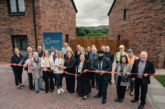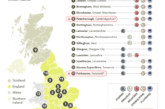The Communities and Housing Investment Consortium (CHIC) offers advice on identifying RAAC for local authorities and other public sector organisations.
Recently, there has been significant coverage in UK news outlets regarding the issue of unsafe buildings. Reinforced Autoclaved Aerated Concrete (RAAC), a lightweight type of precast concrete, was commonly used in public sector construction during the period spanning from the mid 1960s to the 1990s, prior to its replacement by newer methods of construction.
While the news headlines focus on schools, RAAC was utilised in all public sector buildings, which may constitute a significant portion of local government assets. CHIC’s goal is to ensure that it’s members are well equipped to identify and address this problem effectively.
RAAC is primarily used in roofs, with occasional utlisiation in floors and walls. Visually, RAAC planks can closely resemble pre-cast concrete and may be concealed above false ceilings. It’s crucial to have access to the appropriate consultancy firms for identifying whether your building contains RAAC and CHIC can facilitate quick and easy access to these firms.
Why it is a problem
So, what makes RAAC concrete a concern? It’s less resilient compared to traditional concrete, leading to potential safety risks. While RAAC was once favoured for crafting lightweight, pre-formed concrete elements, its structural integrity has deteriorated over time, resulting in sagging and reduced structural integrity.
Research indicates that RAAC has a significantly lower load bearing capacity compared to other reinforced concrete products. Also, its condition worsens when exposed to water, such as leaks from roofs, which can compromise the reinforcement bars. We have seen reports recently that over 150 education facilities are confirmed to have a collapse risk and the numbers are still on the rise.
Although RAAC was widely considered a cost-effective alternative to standard concrete, with quicker production and easier installation, the estimated lifespan of these planks is approximately 30 years. Replacement costs are estimated at £1,000 per square metre for a RAAC roof.
How did this fly under the radar?
The initial cases emerged within UK universities. Nearly three decades ago, it became evident that the durability of RAAC in various public buildings, including hospitals and schools, would not exceed 30 years.
Surprisingly, little action was taken in response to this. Addressing this issue has been long overdue and the decision to do so coincides with one of the most disruptive periods we have seen in a while. However, this needs to be a top priority for local authorities as there are potential risks in some of their buildings.
What needs to be done
CHIC recommends that its members urgently assess whether any structures within their estates incorporate roofs, floors, cladding, or walls constructed from RAAC. You can find an initial identification method outlined in the Department of Education’s guidance document. RAAC panels are more easily identifiable when a building’s structural elements remain uncovered, lacking finishes or decoration. However, a comprehensive survey is essential.
CHIC’s dedicated member services team can assist you in understanding how to approach commissioning appropriate surveys.
How CHIC can help — surveys and solutions
Selecting the appropriate consultants to carry out the surveying and development of an engineering solution for the building, all while ensuring procurement compliance, is a crucial step towards achieving safety and RAAC-free buildings. CHIC has established a readily accessible route to market.
CHIC’s Consultancy Framework offers a comprehensive variety of consultancy services incorporating construction, building safety and other housing disciplines. These services are intended to assist CHIC’s members across a wide range of projects and programmes that require professional consultancy support.
Luke Hurd, Chief Operating Officer, said: “It is disconcerting that much of the sector appears to be caught off guard by this situation and we must strive to become more proactive rather than reactive within affordable housing. CHIC can offer effective solutions to assist our members in addressing this issue and our dedicated member services team is fully equipped to oversee the entire procurement process.
“We have assembled a wide selection of approved suppliers who hold the necessary experience and expertise to guide our members through the various stages of eliminating RAAC. This includes identification surveys and the replacement of materials.”
CHIC’s expert approved consultants include:
- Alderton Associates Ltd
- Ark Consultancy
- Baily Garner LLP
- Beta Design Consultants
- Calfordseaden LLP
- Curtins Consulting Ltd
- Faithorn Farrell Timms LLP
- Frankham Consultancy
- Global HSE Solutions
- JNP Group
- John Rowan and Partners
- Keegans
- Keelagher Okey Klein
- Newtecnic
- O’Connor Sutton Cronin
- PellingsLLP
- Pennington Choices Ltd
- Potter Raper Ltd
- Price & Myers LLP
- Rapleys LLP
- Rider Levett Bucknall UK
- Ridge and Partners LLP
- Robinson Low Francis LLP
- Savills UK
- Summers-Inman
- The Fulker Consultancy
Many of these organisations are equipped to offer expert guidance on initially detecting the presence of RAAC concrete in your homes and subsequently outlining the safe removal and replacement processes with more sustainable materials. If required, CHIC also has solutions in place for demolition and retrofitting under it’s Development DPS and soon to be landed newbuild framework.
What some of CHIC’s partners had to say
Frankham Group: Our experts will liaise with you directly and arrange to visit your sites, undertaking carefully planned investigations to determine the structural safety risk and advise on any remedial actions required at every step. You can trust our expertise to ensure your estates management teams have confidence in allowing safe use of their assets.
Faithorn Farrell Timms: At FFT, we have hands-on experience in carrying out RAAC surveys and reports and contract managing remedial works. We are currently under instruction for numerous dioceses and educational trusts, health and housing clients. Our specialists in this area are all RICS Chartered Building Surveyors (FRICS/MRICS) and all survey commissions are overseen at Partner level for added reassurance.
It is important to note that the assessment of RAAC is a highly specialised area within the surveying profession, and it is vital to ensure that those carrying out the surveys are suitably qualified and can demonstrate an appropriate level of skill and experience.
Beta Design Consultants: We have developed a unique approach that follows the Institution of Structural Engineers — further guidance. Our unique offers the following benefits:
1.Tiered approach, starting with visual inspection, followed by further investigation (coring, NDT, lab testing), followed by recommendation for action. Clients only pays for the stage that is needed and moves to the next stage only if necessary, so more control.
2.Integrated approach, because we offer all of the above activities, the process is streamlined and much faster. Clients deal with one body only — with a project structural engineer assigned for each asset or portfolio.
3.Practical approach, because we have been working with members of the Concrete Repair Association for six years on a concrete repair project and because we have been providing temporary works design as a service.
4.Proven approach, based on case studies that include the repairs for many assets — case studies to be shared on request.
Calford Seaden: We have been looking at this as part of a multi-disciplinary approach where our Surveyors and Structural Engineers can identify and advise on any immediate mitigation. We can pick this up as part of another survey or as a stand-alone option depending on requirements. Should RAAC be found, we can advise on the scope, level of risk and costs of any necessary remedial work. Further, as a multi-disciplinary practice we can advise and support should any corrective works be required.
JNP Group: The Health and Safety Executive said: “RAAC is now beyond its lifespan and may collapse with little or no notice.” Due to life expectancy and the possibility of structural failure of RAAC, the priority action for building owners is to establish whether RAAC is present. Published Structural reports state life expectancy of RAAC is 30 years.
RAAC was used and can still be found in schools, hospitals, and other public sector buildings. Reinforced autoclaved aerated concrete (RAAC), a lightweight building material specifically designed for flat roofing in the 1950s and 1990s but also used in walls and floors.
JNP Group can provide expert guidance in locating its presence. JNP Group are experienced structural engineers who are knowledgeable about RAAC. As a supplier to CHIC, our team is on hand to attend site and efficiently provide an assessment for the presence of RAAC.
If you would like to access CHIC’s services to deliver your site surveys, or would like some more information about how they can help, please get in touch with a member of the team at enquiries@chicltd.co.uk or visit the CHIC website chicltd.co.uk
Header image: ©Direk Takmatcha/AdobeStock










